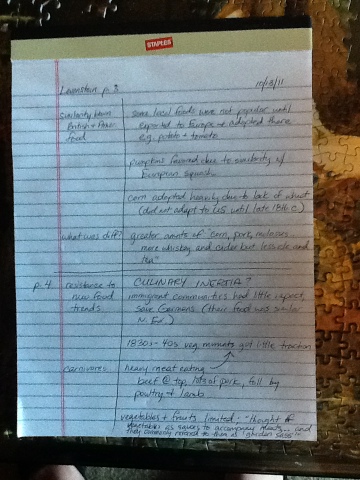Presentations were done tonight, I think it went fairly well. I’m posting the final version of my paper below. Feel free to ask questions or give feedback!
“For the improvement of the rising generation of Females”: Amelia Simmons’ American Cookery and the Development of the American Woman
While traditionally ignored by scholars due to their position as utilitarian rather than literary/expressive texts, cookbooks have somewhat recently become an object of cultural and historical analysis. They provide a valuable window into the foodways of the culture publishing and purchasing them, and food not only literally sustains the population but its regional and class differences help to define that population’s culture. Much of this work, therefore, has sought to demonstrate the function of cookbooks to inscribe and reproduce national and ethnic identity. While this analysis of the overall culture has been illuminating and valuable, however, the fact that numerous cultures have generally assigned cooking responsibilities to one gender—women—demands greater acknowledgment in their analysis; what can these texts tell us specifically about the circumstances, social roles, and opportunities of the individuals who will be actually carrying out their instructions?
A cultural identity-based pattern of inquiry can be clearly seen when dealing with the first cookbook authored by an American, Amelia Simmons’ American Cookery (1796). The two declarations of the book and author’s American identities on the title page alone begin to demonstrate that this text was part of an effort to define a unique identity for the United States of America, distinct from its British origins even down to its food. Simplified recipes and local ingredients such as corn and pumpkin, originally adopted out of necessity, now became a marker of hardy, egalitarian American sensibilities. As James McWilliams notes in his survey of the development of American foodways, these local crops “were symbolic reflections of the ceaseless toil that Americans and their slaves, servants, and children invested in the ongoing quest for self-sufficiency” (145). The use of corn in particular was frequently rejected and ridiculed by European commentators; as Glynis Ridley points out, “when repeated dislike and disdain is expressed by writers of one nation toward a bulwark of the diet of another, then dietary insults shade into national insults” and thus Amelia Simmons’ cookbook serves as a defense of corn as legitimate and enjoyable alongside other remarks on its quality from figures like Ben Franklin (118).[1] In her analysis of American Cookery’s political functions, Glynis Ridley also notes how Simmons herself becomes a part of the discourse defining American independence; the author, identified as an American Orphan, revives “easily the most common trope of anti-British satire in the period 1763-83,” that of America as the child of overbearing Britain in a relationship so soured that “America is effectively an orphan” (115).
The author and the intended audience of American Cookery were not simply Americans, however, but specifically American women. Simmons’ introductory preface shows an almost strange fixation on development and change, stating that the cookbook is “calculated for the improvement of the rising generation of Females in America” (3). Young women, presumably like Simmons herself, live in a “world … so variable, that old people cannot accommodate themselves to the various changes and fashions which daily occur … while the young and the gay, bend and conform readily to the taste of the times” (Simmons 3). This statement, in the middle of a preface to a cookbook discussing the problems of orphans, seems strange until one considers that like America overall, women after the Revolution experienced great changes in domestic responsibilities, educational opportunities, and the significance of their gender’s social role. As an aide for a core domestic pursuit, American Cookery not only participates in a developing discourse of national identity but also illustrates and argues for a changing image of urban, educated Republican womanhood. Thus the figure of Amelia Simmons as author and the components of her cookbook, while aimed for “all grades of life,” primarily reflect the urban female population and advocate in new debates over public education for women (Simmons 1).

